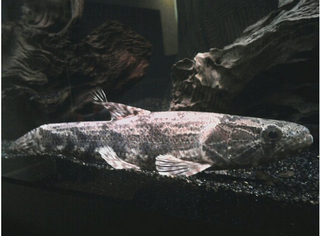
Pygocentrus is a genus of the piranha family Serrasalmidae. All species are native to tropical and subtropical South America. All the species are predatory, scavengers and may form large schools. The famous red-bellied piranha, Pygocentrus nattereri, is one of four species in the genus.
Denticetopsis sauli is a species of whale catfish endemic to Venezuela, where it is only known from the Pamoni River in the Casiquiare River basin of the upper Rio Negro system. This species grows to a length of 2.1 cm.
Myleusnema bicornis is an intestinal parasite of Myleus ternetzi, or "Ternetz's Silver Dollar", a freshwater Characoid fish commonly found in the French Guiana river. M. bicornis has several unusual morphological characteristics, namely the two postcloacal "horns" in the posterior of males, and a separate elongated cephalic region (head) that may be extended and retracted. These features differ vastly from other Cosmocercoidean nematodes, as well as any others within the family Kathlaniidae, and as such necessitate the creation of the new genus Myleusnema; however, no genetic taxonomic studies have been performed.

Hoplias aimara, also known as anjumara, traira, trahira, manjuma, anjoemara and wolf fish, is a species of freshwater fish found in the rivers of South America. In Amazonia, the native populations are concerned by high levels of mercury contamination which has been linked to the consumption of contaminated fish. H. aimara is a good bioindicator of such contamination.

Hoplias is a genus of fish in the family Erythrinidae found in Central and South America.

Hoplias australis is a predatory freshwater characin fish of the southern Neotropics.
Hoplias brasiliensis is a species of trahiras. It is a benthopelagic, tropical freshwater fish which is known from coastal rivers in northeastern Brazil, including the Paraguaçu River in Bahia, the Pardo River, the Jequitinhonha River in Minas Gerais and Espírito Santo, and the Contas River. Male H. brasiliensis can reach a maximum length of 20.3 centimetres.
Hoplias lacerdae is a predatory freshwater characin fish from South America. The are commonly known are trairão in Brazilian Portuguese.
Hoplias microcephalus is a species of trahiras. It is a tropical, benthopelagic freshwater fish which is known to inhabit the São Francisco River in Brazil. Males can reach a maximum length of 35.6 centimetres.
Hoplias teres is a species of trahiras. It is a tropical, benthopelagic freshwater fish which is known to inhabit Lake Maracaibo in Venezuela. Males can reach a maximum length of 15.3 centimetres.

Erythrinus erythrinus, the red wolf fish, is a relatively small species of trahira from freshwater habitats in South America.
Erythrinus kessleri is a species of trahira. It is a tropical, freshwater fish which is known from coastal rivers in Bahia, Brazil; the type locality is the Itapicuru River. It was described by Franz Steindachner in 1877. Males can reach a maximum standard length of 19 centimetres.
Hoplerythrinus cinereus is a species of trahira. It is a tropical, pelagic freshwater fish which is known from the Island of Trinidad off northeastern Venezuela. Males can reach a maximum standard length of 20.2 cm.
Albula argentea, the silver sharpjaw bonefish, is a species of marine fish found in the tropical western Pacific Ocean. They grow up to 70 cm (28 in).

The shovelnose sea catfish, also called the short-nosed catfish or the marine catfish, is a species of sea catfish in the family Ariidae. It was described by Achille Valenciennes in 1840. It is a non-migratory species which inhabits tropical marine and brackish waters in the Indo-western Pacific region, including Indonesia, India, Pakistan, the Philippines and Thailand. It dwells at a depth range of 0 to 20 m. It reaches a maximum NG length of 39.5 cm (15.6 in), while commonly reaching a total length of 12 cm (4.7 in).

The veined catfish, also known as the marine catfish, is a species of sea catfish in the family Ariidae. It was described by Achille Valenciennes in 1840. It inhabits tropical marine and brackish waters in the Indo-western Pacific region, including the Mozambique Channel, Myanmar, Indonesia and southern China. It dwells at a depth range of 20 to 50 m. It reaches a maximum total length of 30 cm (12 in), but more commonly reaches a TL of 19 cm (7.5 in).
The Bressou sea catfish, also called the marine catfish, is a species of sea catfish in the family Ariidae. It was described by Achille Valenciennes in 1840, originally under the genus Arius. It inhabits tropical marine, brackish and freshwater on the Atlantic coast of South America, ranging from Guyana to Brazil. It reaches a maximum total length of 50 cm (20 in), but more commonly reaches a TL of 30 cm (12 in).
Crenicichla reticulata is a species of cichlid native to South America, where it occurs in the Amazon River of Brazil, Colombia and Peru and the Essequibo River of Guyana.

Trachelyopterus insignis is a species of catfish from the freshwater driftwood catfish family, Auchenipteridae. It is commonly found in rivers of northern South America, where it is called the chivo, the rengue, or the doncella.
Hyphessobrycon albolineatum is a South American species of tetra in the family Characidae.







